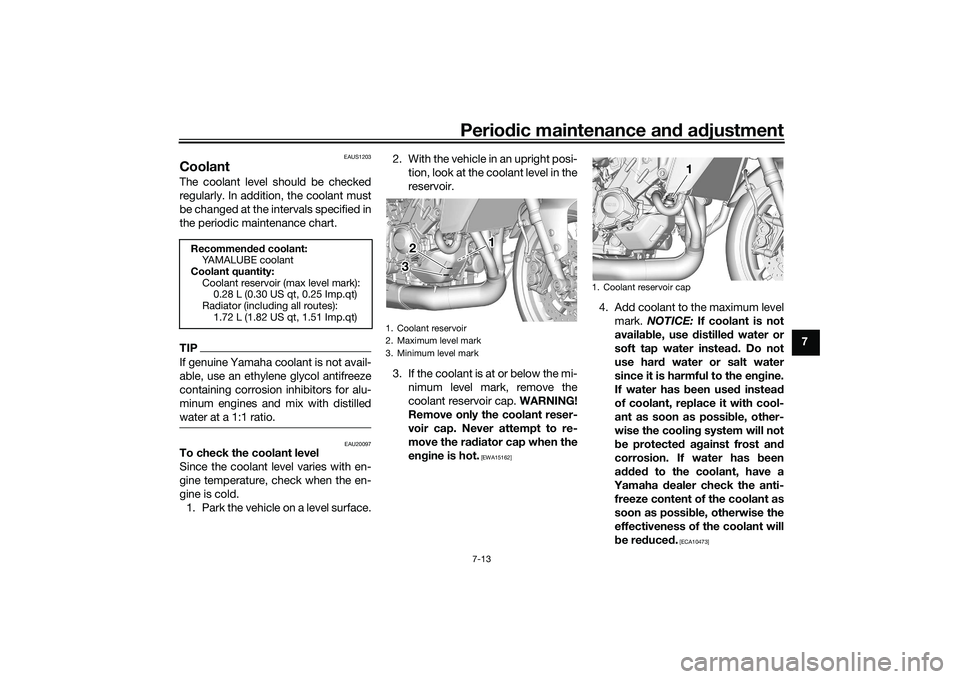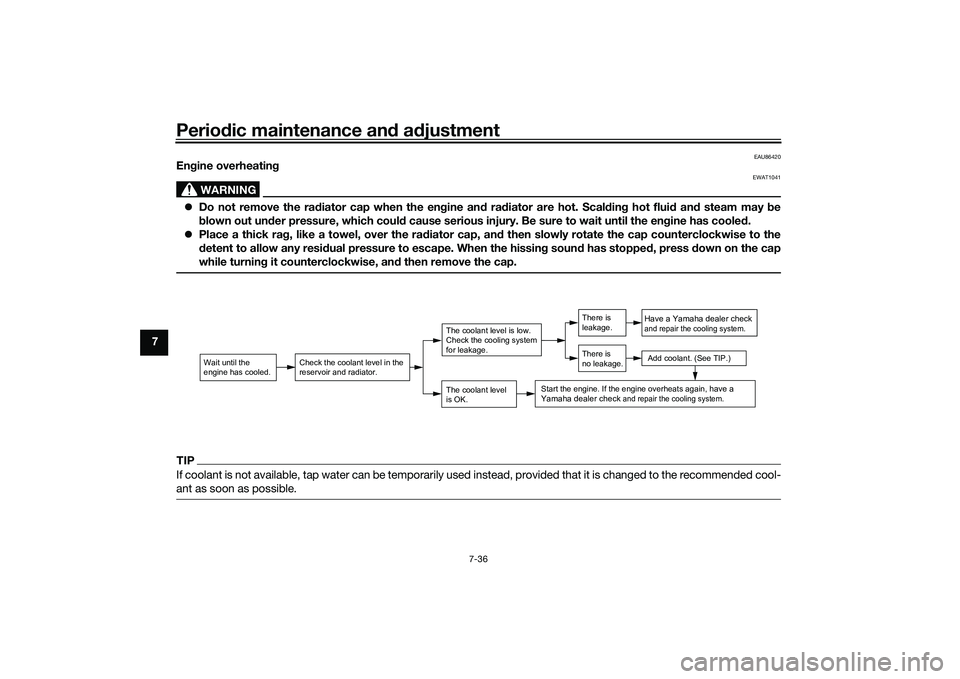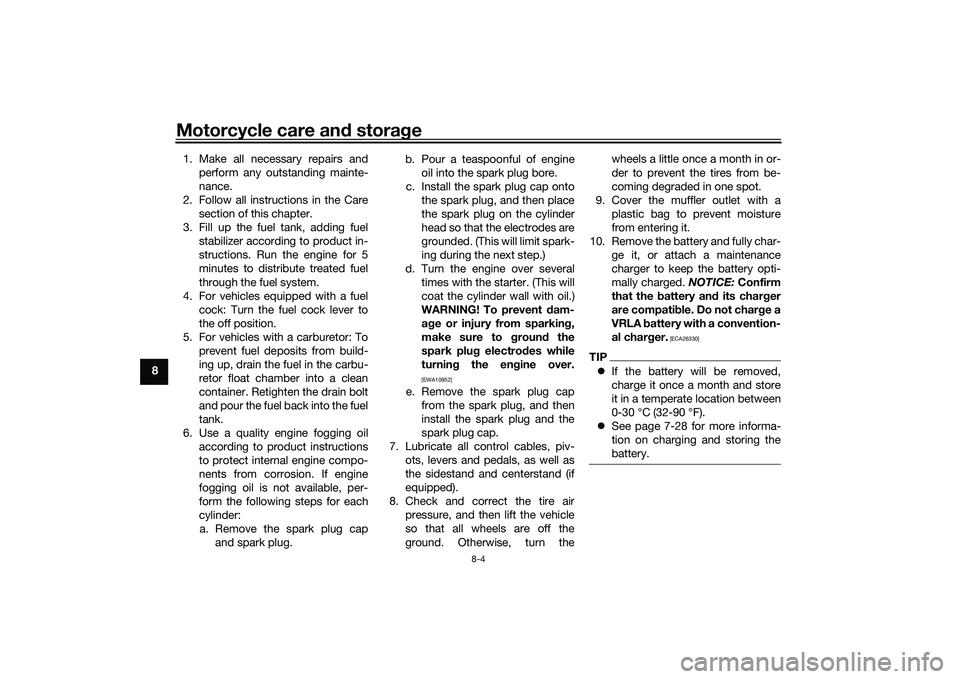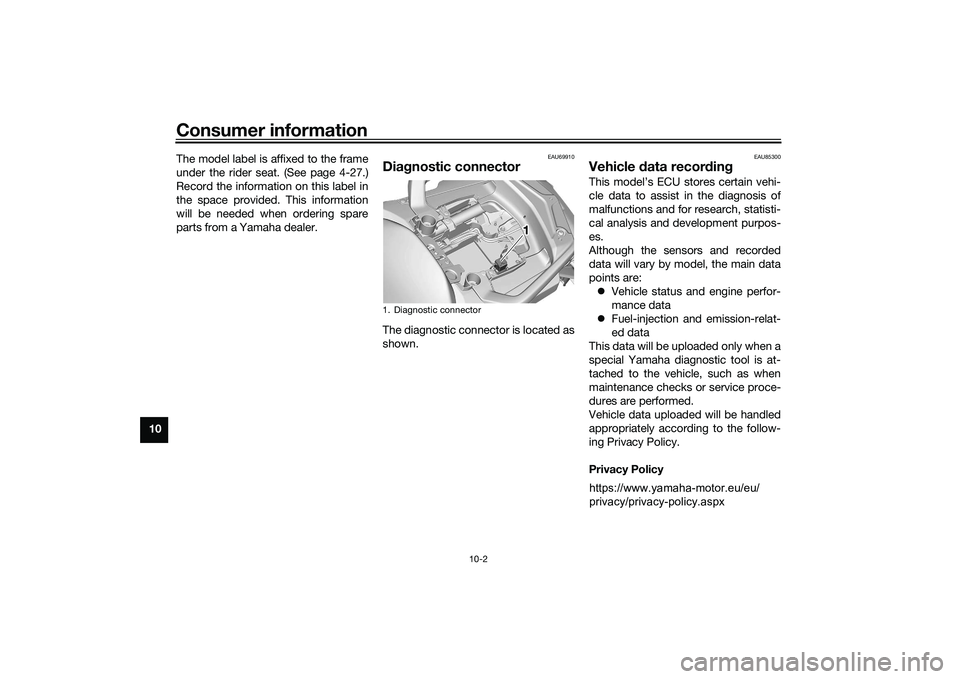check engine YAMAHA TRACER 900 2021 Owner's Manual
[x] Cancel search | Manufacturer: YAMAHA, Model Year: 2021, Model line: TRACER 900, Model: YAMAHA TRACER 900 2021Pages: 118, PDF Size: 4.38 MB
Page 81 of 118

Periodic maintenance an d a djustment
7-13
7
EAUS1203
CoolantThe coolant level should be checked
regularly. In addition, the coolant must
be changed at the intervals specified in
the periodic maintenance chart.TIPIf genuine Yamaha coolant is not avail-
able, use an ethylene glycol antifreeze
containing corrosion inhibitors for alu-
minum engines and mix with distilled
water at a 1:1 ratio.
EAU20097
To check the coolant level
Since the coolant level varies with en-
gine temperature, check when the en-
gine is cold.
1. Park the vehicle on a level surface. 2. With the vehicle in an upright posi-
tion, look at the coolant level in the
reservoir.
3. If the coolant is at or below the mi- nimum level mark, remove the
coolant reservoir cap. WARNING!
Remove only the coolant reser-
voir cap. Never attempt to re-
move the ra diator cap when the
en gine is hot.
[EWA15162]
4. Add coolant to the maximum level
mark. NOTICE: If coolant is not
availab le, use distille d water or
soft tap water instead . Do not
use har d water or salt water
since it is harmful to the en gine.
If water has been used instead
of coolant, replace it with cool-
ant as soon as possi ble, other-
wise the coolin g system will not
b e protecte d a gainst frost an d
corrosion. If water has been
a dd ed to the coolant, have a
Yamaha dealer check the anti-
freeze content of the coolant as
soon as possi ble, otherwise the
effectiveness of the coolant will
b e re duce d.
[ECA10473]
Recommen ded coolant:
YAMALUBE coolant
Coolant quantity: Coolant reservoir (max level mark):0.28 L (0.30 US qt, 0.25 Imp.qt)
Radiator (including all routes): 1.72 L (1.82 US qt, 1.51 Imp.qt)
1. Coolant reservoir
2. Maximum level mark
3. Minimum level mark
1 1
2 1
2
3 3
1. Coolant reservoir cap
1 1 1
UB5UE0E0.book Page 13 Wednesday, December 23, 2020 11:03 AM
Page 82 of 118

Periodic maintenance an d a djustment
7-14
7 5. Install the coolant reservoir cap.
EAU33032
Chan
gin g the coolant
The coolant must be changed at the in-
tervals specified in the periodic main-
tenance and lubrication chart. Have a
Yamaha dealer change the coolant.
WARNING! Never attempt to remove the ra diator cap when the en gine is
hot.
[EWA10382] EAU36765
Air filter elementThe air filter element must be replaced
at the intervals specified in the periodic
maintenance and lubrication chart.
Have a Yamaha dealer replace the air
filter element.
EAU44735
Checkin
g the en gine i dlin g
spee dCheck the engine idling speed and, if
necessary, have it corrected by a
Yamaha dealer.En gine i dlin g spee d:
1200–1400 r/min
UB5UE0E0.book Page 14 Wednesday, December 23, 2020 11:03 AM
Page 83 of 118

Periodic maintenance an d a djustment
7-15
7
EAU21403
Valve clearanceThe valves are an important engine
component, and since valve clearance
changes with use, they must be
checked and adjusted at the intervals
specified in the periodic maintenance
chart. Unadjusted valves can result in
improper air-fuel mixture, engine
noise, and eventually engine damage.
To prevent this from occurring, have
your Yamaha dealer check and adjust
the valve clearance at regular intervals.TIPThis service must be performed when
the engine is cold.
EAU64412
TiresTires are the only contact between the
vehicle and the road. Safety in all con-
ditions of riding depends on a relatively
small area of road contact. Therefore, it
is essential to maintain the tires in good
condition at all times and replace them
at the appropriate time with the speci-
fied tires.
Tire air pressure
The tire air pressure should be
checked and, if necessary, adjusted
before each ride.
WARNING
EWA10504
Operation of this vehicle with im-
proper tire pressure may cause se-
vere injury or d eath from loss of
control. The tire air pressure must b e
checked and a djuste d on col d
tires (i.e., when the temperature
of the tires equals the am bient
temperature).
The tire air pressure must b e
a d juste d in accor dance with the
ri din g speed and with the total wei
ght of ri der, passen ger, car-
g o, an d accessories approve d
for this mo del.
WARNING
EWA10512
Never overloa d your vehicle. Opera-
tion of an overloa ded vehicle coul d
cause an acci dent.
Col d tire air pressure:
1 person: Front:250 kPa (2.50 kgf/cm², 36 psi)
Rear: 290 kPa (2.90 kgf/cm², 42 psi)
2 persons:
Front:250 kPa (2.50 kgf/cm², 36 psi)
Rear:
290 kPa (2.90 kgf/cm², 42 psi)
Maximum loa d:
Vehicle:
193 kg (425 lb)
The vehicle’s maximum load is the
combined weight of the rider, pas-
senger, cargo, and any accessories.
UB5UE0E0.book Page 15 Wednesday, December 23, 2020 11:03 AM
Page 103 of 118

Periodic maintenance an d a djustment
7-35
7
EAU86350
Trou bleshootin g chart
Check the fuel level in
the fuel tank.1. Fuel
There is enough fuel.
There is no fuel.
Check the battery.
Supply fuel.
The engine does not start.
Check the battery.
Try starting the engine.4. Compression
There is compression.
There is no compression.
The engine does not start.
Have a Yamaha dealer check the vehicle.Have a Yamaha dealer check the vehicle.
Remove the spark plug
and check the electrodes.3. Ignition
Wipe off with a dry cloth and correct the
spark plug gap, or replace the spark plug(s). Have a Yamaha dealer check the vehicle.
The engine does not start.
Check the compression.
Operate the electric starter.2. Battery
The engine turns over
quickly.
The engine turns over
slowly.
The battery is good.
DryWet
Try starting the engine.
Check the battery lead connections,
and charge the battery if necessary.
The engine does not start.
Check the ignition.
UB5UE0E0.book Page 35 Wednesday, December 23, 2020 11:03 AM
Page 104 of 118

Periodic maintenance an d a djustment
7-36
7
EAU86420
En gine overheatin g
WARNING
EWAT1041
Do not remove the ra diator cap when the en gine an d ra diator are hot. Scal din g hot flui d an d steam may be
b lown out un der pressure, which coul d cause serious injury. Be sure to wait until the en gine has coole d.
Place a thick ra g, like a towel, over the ra diator cap, an d then slowly rotate the cap counterclockwise to the
d etent to allow any resi dual pressure to escape. When the hissin g soun d has stoppe d, press d own on the cap
while turnin g it counterclockwise, an d then remove the cap.TIPIf coolant is not available, tap water can be temporarily used instead, provided that it is changed to the recommended cool-
ant as soon as possible.
Wait until the
engine has cooled.
Check the coolant level in the
reservoir and radiator.
The coolant level
is OK.The coolant level is low.
Check the cooling system
for leakage.
Have a Yamaha dealer checkand repair the cooling system.Add coolant. (See TIP.)
Start the engine. If the engine overheats again,
have a
Yamaha dealer check
and repair the cooling system.
There is
leakage.
There is
no leakage.
UB5UE0E0.book Page 36 Wednesday, December 23, 2020 11:03 AM
Page 108 of 118

Motorcycle care and stora ge
8-4
8 1. Make all necessary repairs and
perform any outstanding mainte-
nance.
2. Follow all instructions in the Care section of this chapter.
3. Fill up the fuel tank, adding fuel stabilizer according to product in-
structions. Run the engine for 5
minutes to distribute treated fuel
through the fuel system.
4. For vehicles equipped with a fuel cock: Turn the fuel cock lever to
the off position.
5. For vehicles with a carburetor: To prevent fuel deposits from build-
ing up, drain the fuel in the carbu-
retor float chamber into a clean
container. Retighten the drain bolt
and pour the fuel back into the fuel
tank.
6. Use a quality engine fogging oil according to product instructions
to protect internal engine compo-
nents from corrosion. If engine
fogging oil is not available, per-
form the following steps for each
cylinder:a. Remove the spark plug cap and spark plug. b. Pour a teaspoonful of engine
oil into the spark plug bore.
c. Install the spark plug cap onto the spark plug, and then place
the spark plug on the cylinder
head so that the electrodes are
grounded. (This will limit spark-
ing during the next step.)
d. Turn the engine over several times with the starter. (This will
coat the cylinder wall with oil.)
WARNING! To prevent d am-
a g e or injury from sparkin g,
make sure to groun d the
spark plu g electro des while
turnin g the en gine over.
[EWA10952]
e. Remove the spark plug cap
from the spark plug, and then
install the spark plug and the
spark plug cap.
7. Lubricate all control cables, piv- ots, levers and pedals, as well as
the sidestand and centerstand (if
equipped).
8. Check and correct the tire air pressure, and then lift the vehicle
so that all wheels are off the
ground. Otherwise, turn the wheels a little once a month in or-
der to prevent the tires from be-
coming degraded in one spot.
9. Cover the muffler outlet with a plastic bag to prevent moisture
from entering it.
10. Remove the battery and fully char- ge it, or attach a maintenance
charger to keep the battery opti-
mally charged. NOTICE: Confirm
that the battery an d its char ger
are compati ble. Do not char ge a
VRLA battery with a convention-
al char ger.
[ECA26330]
TIP If the battery will be removed,
charge it once a month and store
it in a temperate location between
0-30 °C (32-90 °F).
See page 7-28 for more informa-
tion on charging and storing the
battery.
UB5UE0E0.book Page 4 Wednesday, December 23, 2020 11:03 AM
Page 112 of 118

Consumer information
10-2
10The model label is affixed to the frame
under the rider seat. (See page 4-27.)
Record the information on this label in
the space provided. This information
will be needed when ordering spare
parts from a Yamaha dealer.
EAU69910
Dia
gnostic connectorThe diagnostic connector is located as
shown.
EAU85300
Vehicle data recor din gThis model’s ECU stores certain vehi-
cle data to assist in the diagnosis of
malfunctions and for research, statisti-
cal analysis and development purpos-
es.
Although the sensors and recorded
data will vary by model, the main data
points are:
Vehicle status and engine perfor-
mance data
Fuel-injection and emission-relat-
ed data
This data will be uploaded only when a
special Yamaha diagnostic tool is at-
tached to the vehicle, such as when
maintenance checks or service proce-
dures are performed.
Vehicle data uploaded will be handled
appropriately according to the follow-
ing Privacy Policy.
Privacy Policy
1. Diagnostic connector
1 1 1
https://www.yamaha-motor.eu/eu/
privacy/privacy-policy.aspx
UB5UE0E0.book Page 2 Wednesday, December 23, 2020 11:03 AM
Page 114 of 118

11-1
11
IndexAABS warning light ................................... 4-7
Air filter element .................................... 7-14
Auxiliary DC connectors ....................... 4-36
Auxiliary DC jack ................................... 4-36
Auxiliary system warning light ................ 4-9BBattery .................................................. 7-28
BC ........................................................... 3-6
Brake and clutch levers, checking and
lubricating ........................................... 7-25
Brake and shift pedals, checking and
lubricating ........................................... 7-25
Brake control system (BC) .................... 4-22
Brake fluid, changing ............................ 7-21
Brake fluid level, checking .................... 7-20
Brake lever ............................................ 4-22
Brake lever free play, checking............. 7-18
Brake light switches.............................. 7-19
Brake pedal........................................... 4-22CCables, checking and lubricating ......... 7-24
Canister................................................. 7-10
Care ........................................................ 8-1
Catalytic converter ................................ 4-27
Centerstand and sidestand, checking
and lubricating .................................... 7-26
Clutch lever ........................................... 4-21
Clutch lever free play, adjusting ........... 7-18
Coolant ................................................. 7-13
Cruise control indicator lights ................. 4-6
Cruise control switches .......................... 4-4
Cruise control system ............................. 3-1
DData recording, vehicle ........................ 10-2
Diagnostic connector ........................... 10-2
Dimmer/Pass switch .............................. 4-3
Display, menu screen ........................... 4-17
Displays .................................................. 4-9
D-MODE ................................................. 3-3
Drive chain, cleaning and lubricating ... 7-23
Drive chain slack .................................. 7-22EEngine break-in ...................................... 6-1
Engine idling speed, checking ............. 7-14
Engine oil .............................................. 7-10
Engine overheating ............................... 7-36
Engine serial number ............................ 10-1FFront and rear brake pads, checking ... 7-19
Front fork, adjusting ............................. 4-32
Front fork, checking ............................. 7-27
Fuel ....................................................... 4-24
Fuel consumption, tips for reducing ...... 6-4
Fuel level warning light ........................... 4-6
Fuel tank cap ........................................ 4-24
Fuel tank overflow hose ....................... 4-26
Fuses, replacing ................................... 7-30HHandlebar position, adjusting .............. 4-32
Handlebar switches ................................ 4-3
Hazard switch......................................... 4-4
High beam indicator light ....................... 4-6
Horn switch ............................................ 4-4IIdentification numbers .......................... 10-1
Ignition circuit cut-off system ............... 4-37 Immobilizer system .................................4-1
Immobilizer system indi
cator light ..........4-8
Indicator lights and warning lights ..........4-6
LLicense plate light bulb, replacing ........7-32
Luggage strap holders ..........................4-35MMain switch/steering lock .......................4-2
Maintenance and lubrication, periodic....7-5
Maintenance, emission control system ..................................................7-3
Malfunction indicator light (MIL)..............4-7
Matte color, caution ................................8-1
Model label ...........................................10-1NNeutral indicator light ..............................4-6OOil pressure and Coolant temperature warning light .........................................4-8PParking ....................................................6-5
Part locations ..........................................2-1QQSS (if equipped) ....................................3-6RRider footrest position, adjusting ..........4-31
Rider seat height, adjusting ..................4-28SSafety information ...................................1-1
Seats .....................................................4-27
Shifting ....................................................6-3
Shift pedal .............................................4-21
Shock absorber assembly, adjusting ....4-34
Sidestand ..............................................4-37
UB5UE0E0.book Page 1 Wednesday, December 23, 2020 11:03 AM
Page 115 of 118

Index
11-2
11
Spark plugs, checking ............................ 7-9
Special features ...................................... 3-1
Specifications ......................................... 9-1
Stability control indicator light ................ 4-8
Starting the engine ................................. 6-2
Steering, checking ................................ 7-28
Stop/Run/Start switch ............................ 4-4
Storage ................................................... 8-3
Storage compartment .......................... 4-31
Swingarm pivots, lubricating ................ 7-27TTCS-MODE............................................. 3-4
Throttle grip, checking and
lubricating........................................... 7-24
Tires ...................................................... 7-15
Tool kit .................................................... 7-2
Troubleshooting.................................... 7-33
Troubleshooting chart .......................... 7-35
Turn signal indicator lights ..................... 4-6
Turn signal switch................................... 4-4VValve clearance .................................... 7-15
Vehicle identification number ............... 10-1
Vehicle lights ........................................ 7-32WWheel bearings, checking .................... 7-28
Wheels .................................................. 7-17
Windshield ............................................ 4-31YYamalube.............................................. 7-12
UB5UE0E0.book Page 2 Wednesday, December 23, 2020 11:03 AM